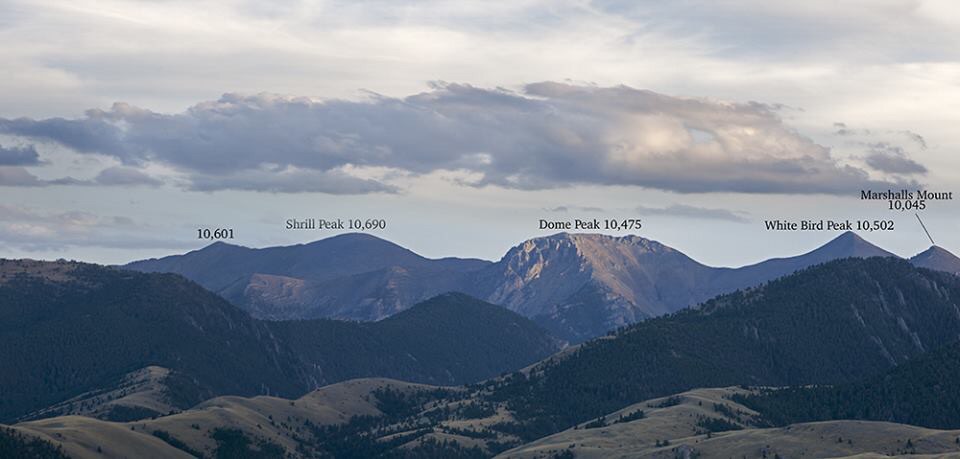
The Lemhi Range is discussed on Pages 295-318 of the book. All Lemhi Range peaks included on this website can be found at this link: Lemhi Range Updates.
The Lemhi Range is a quintessential linear mountain chain that runs from Salmon, Idaho in a southeasterly direction for over 100 miles to the Snake River Plain. It varies in width from 10 to 15 miles. The Pahsimeroi and Little Lost River Valleys border the range on its western side. The Lemhi and Birch Creek Valleys parallel its eastern side. The range was named Lemhi in 1917 (Lemhi is a corruption of Limhi from the Book of Mormon). Signs of Native American habitation dating from 8,000 years ago can be found along the base of the range, but their name for the range is lost in time.
The range has 118 peaks rising above 10,000 feet: one 12er, nine 11ers and 108 10ers. Diamond Peak is the highest summit at 12,197 feet.
Click here for LEMHI RANGE ACCESS UPDATES
The Lemhis are a basin and range fault block composed of limestone, quartzite, and related sedimentary deposits. Glaciation along the crest has carved the rock at will. While many peaks are nothing more than incredible piles of talus/scree, others are solid blocks that present impressive faces to the valleys below. The range’s crest consistently rises more than 4,000 feet above the broad alluvial valleys that flank it, staying above 10,000 feet in elevation. The range is broadest in the north with high peaks, remote valleys, and dozens of mountain lakes. The central Lemhis are narrower, steeper, drier, and higher than the northern peaks. They include the range’s most impressive peaks: 12,197-foot Diamond Peak and 11,618-foot Bell Mountain. The southern end of the Lemhi Range, south of Saddle Mountain, is a semi-desert region characterized by deep canyons and massive cliffs. The two most impressive of these canyons are Box Canyon and East Canyon. Box Canyon is a winding canyon that shelters several important archaeological sites and some impressive cliffs. East Canyon, north of Box Canyon, is most noted for its tremendous limestone cliffs, the largest of which is capped by a large natural bridge. Both canyons were used extensively by prehistoric inhabitants. More than 18 archaeological sites have been identified in and around the canyons.

The Lemhi peaks. This view east from Iron Creek Point includes Big Creek Peak (left skyline) and Flat Iron Peak to its right.
The Lemhi Range is studded with challenging summits, most of which are inexplicably unnamed. For example, not one of the 11 fine peaks on the Fallert Springs USGS quad is named. Rick Baugher may have captured the range’s character best when he wrote:
There are not many places like the Lemhi Range left. Its fragile alpine life zone grows more than 200 types of plants. Some, such as the Arctic poppy, face extinction. The windswept land above 10,000 feet is home to maybe 400 of Idaho’s best climbers, Oreamnos americanus, the mountain goat. Even as late as 1998, a few of its peaks have yet to be climbed. It is a special place.
The foothills and lower slopes of the Lemhi Range are administered in the north by the BLM. Two national forests share the backbone of the range. The Salmon-Challis National Forest manages the entire northernmost 25 miles and the western side of the crest south to the Snake River Plain. The Targhee National Forest administers the southern half of the Lemhis east of the crest.
Hiking opportunities abound in the northern part of the range where an extensive trail system offers excellent backpacking opportunities. The southern part of the range has few trails, but is suitable for rugged cross-country travel. Recreational use of the range is limited, because few Lemhi Range trailheads are accessible without a 4WD.
Climbing opportunities within the range generally fall within the Class 2 to Class 4 categories, with most of the routes rated Class 3. The broken condition of the rock limits technical climbing. Winter mountaineering involves long approaches up to the base of the mountains. While snowfall is not excessive on the alluvial fans, the wind blows the snow into drifts that prevent vehicle access and leaves much of the ground bare and unsuitable for skiing. Only a few winter ascents have been recorded, although others have undoubtedly occurred.
There has been a significant amount of mining in the range and you will find the remnants of this activity in many spots. Check out Ray Brooks‘ article on peaks and mining in the area of Big Windy Peak which was published in Idaho Magazine.

The tallest Lemhi peak (Diamond Peak) and its neighbors, as viewed from Little Diamond Peak. Larry Prescott Photo
Daniel Todd and Haylee Stocking completed an audacious traverse of the high Lemhi crest between Diamond Peak to Saddle Mountain in 2021. Read about their journey at this link: The Southern Lemhi Traverse by Daniel Todd

Looking north to Mill Mountain. Little Mill Mountain is just off the photo on the right side. Rick Baugher Photo
Click here for LEMHI RANGE ACCESS UPDATES
Regions: EASTERN IDAHO->Lemhi Range
Mountain Range: Lemhi Range









Pingback: From Diamond Peak to Hyndman Peak: Kelly Lance’s 12er Traverse by Tom Lopez - IDAHO: A Climbing Guide